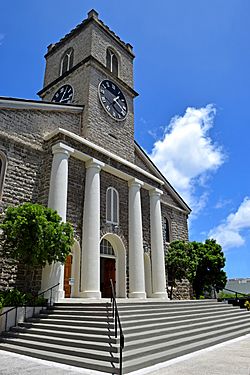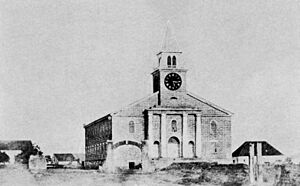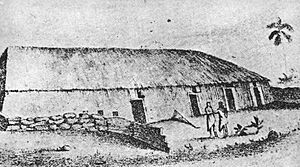Kawaiahaʻo Church facts for kids
Quick facts for kids Kawaiahaʻo Church |
|
|---|---|

Kawaiahaʻo Church is known as the "Westminster Abbey of Hawaiʻi": site of royal weddings, inaugurations, installations, christenings, funerals and tombs.
|
|
| Location | 957 Punchbowl Street Honolulu, Oʻahu, Hawaiʻi |
| Country | United States |
| Language(s) | English and Hawaiian |
| Denomination | United Church of Christ |
| History | |
| Status | Church |
| Architecture | |
| Functional status | Active |
| Style | Neoclassical Mediterranean Revival |
| Years built | 1836–1842 |
| Administration | |
| Division | Hawaii Conference UCC |
Kawaiahaʻo Church is a very old and important church in Downtown Honolulu, on the island of Oʻahu, Hawaiʻi. It's known as "Hawaiʻi's Westminster Abbey" because it was the main church for the Kingdom of Hawaiʻi and the royal family. Many important events happened here, like royal weddings, coronations, and funerals.
The church and nearby Mission Houses are part of the Hawaiian Mission Houses Historic Site. This site was named a U.S. National Historic Landmark in 1962. It was also added to the National Register of Historic Places in 1966.
The name Kawaiahaʻo comes from the Hawaiian words ka wai a Haʻo, meaning "the water of Haʻo." This is because there was a spring and freshwater pool belonging to a high chiefess named Haʻo at this spot. People also called it the "Great Stone Church" or the "King's Church."
Today, Kawaiahaʻo Church still uses the Hawaiian language in some of its services. It is the oldest church on Oʻahu and one of the oldest Christian places of worship in Hawaiʻi. Before this stone church, four churches made of thatch stood near or on this same spot. The oldest standing church in Hawaiʻi is Mokuaikaua Church on the Island of Hawaiʻi. Kawaiahaʻo Church is part of the United Church of Christ.
Contents
History of Kawaiahaʻo Church
The Kawaiahaʻo mission began in 1820. The stone church building was ordered by Queen Kaʻahumanu, who ruled while Kamehameha II and Kamehameha III were kings. Reverend Hiram Bingham designed the church in the New England style, like the homes of the Hawaiian missionaries.
The church was built between 1836 and 1842. Workers used about 14,000 large coral blocks, each weighing thousands of pounds. These blocks were taken from a coral reef off the coast of Oʻahu. Hawaiian divers went three to six meters underwater to cut out each coral block by hand. Then, the blocks were brought from the reef to the shore.
At the same time, the Catholic Church was building the Cathedral of Our Lady of Peace. Construction on that church started in 1840 and finished in 1843, just one year after Kawaiahaʻo Church was completed. The name Kawaiahaʻo was not used for the church until 1853.
Royal Connections and Important Events
Kawaiahaʻo Church was a favorite place for the chiefs of the Hawaiian Islands and members of the Kamehameha and Kalākaua royal families. Kings Kamehameha III, Kamehameha IV, Kamehameha V, and Kalakaua all took their oaths of office here. Important state funerals were also held at the church. Many royal family members were baptized here, even if they later joined other religions.
Today, the upper part of the church has 20 portraits of Hawaiian royalty, called Aliʻi. King Lunalilo is buried in a special room near the front courtyard with his father. He chose to be buried in a church cemetery instead of the Royal Mausoleum.
Not all royal worship happened at Kawaiahaʻo Church. King Kamehameha IV and his wife, Queen Emma, were strong members of the Church of England. They started the Anglican Church of Hawaiʻi. This church later became the Episcopal Diocese of Hawaiʻi after Hawaiʻi became part of the United States.
The royal couple ordered the building of the Cathedral Church of Saint Andrew. This church then became the main place for royal worship. Kings Kamehameha V, Kalākaua, and Queen Liliʻuokalani (after the kingdom was overthrown) preferred to use the cathedral. However, before she became queen, Princess Liliʻuokalani had led the choir at Kawaiahaʻo Church. When Liliʻuokalani died in 1917, her body lay in state at Kawaiahaʻo Church for a week before her funeral at Iolani Palace.
People Connected to Kawaiahaʻo Church
Many well-known people have been connected to Kawaiahaʻo Church, including:
- Kīnaʻu, who was a powerful leader (kuhina nui) in the Hawaiian Kingdom.
- Timothy Kamalehua Haʻalilio, a Hawaiian diplomat who helped Hawaiʻi stay independent.
- John (Ioane) Iʻi, an advisor to King Kamehameha III and a teacher at the Chiefʻs Children School.
- Emma Kaʻili Metcalf Beckley Nakuina, a historian and the first female judge in Hawaiʻi.
- Levi Haʻalelea, another advisor to King Kamehameha III.
- John Thomas Gulick, a missionary who worked in Micronesia and led the Hawaiian board for missions.
- Daniel Opunui, one of the first Protestant missionaries in Micronesia.
- David Kinimaka, the adopted brother of King Kalakaua and an officer in the Hawaiian Royal Guards.
- Henry Berger, the band master of the Royal Hawaiian Band, who is buried at Kawaiahaʻo Church.
- Agnes Baldwin Alexander, who was born in Honolulu in 1875. She was from two important missionary families. In 1900, she learned about the Baháʼí Faith in Rome and became the first Baháʼí in Hawaii in 1901.
- Abraham Akaka, a former pastor of Kawaiahaʻo Church, known for his work in the US Civil Rights Movement.
Senior Pastors (Nā Kahu)
Here is a list of the senior pastors, also known as Nā Kahu, of Kawaiahaʻo Church:
- Hiram Bingham (1820–1840)
- Richard Armstrong (1840–1848)
- Ephraim Weston Clark (1848–1863)
- Henry Hodges Parker (1863–1917)
- Akaiko Akana (1918–1933)
- William Kamau (1934–1940)
- Edward Kahale (1940–1957)
- Abraham Akaka (1957–1984)
- William H. Kaina (1984–1997)
- James Fung (2000–2002)
- Curtis P. Kekuna (2004–2017)
- Kenneth Makuakāne (2018–present)
Interim Pastors
These pastors served for a short time between senior pastors:
- Ronald F.K. Ching (1998)
- James Kimo Mersberg (2017–2018)
See also
 In Spanish: Iglesia de Kawaiaha'o para niños
In Spanish: Iglesia de Kawaiaha'o para niños
- List of the oldest buildings in Hawaii




